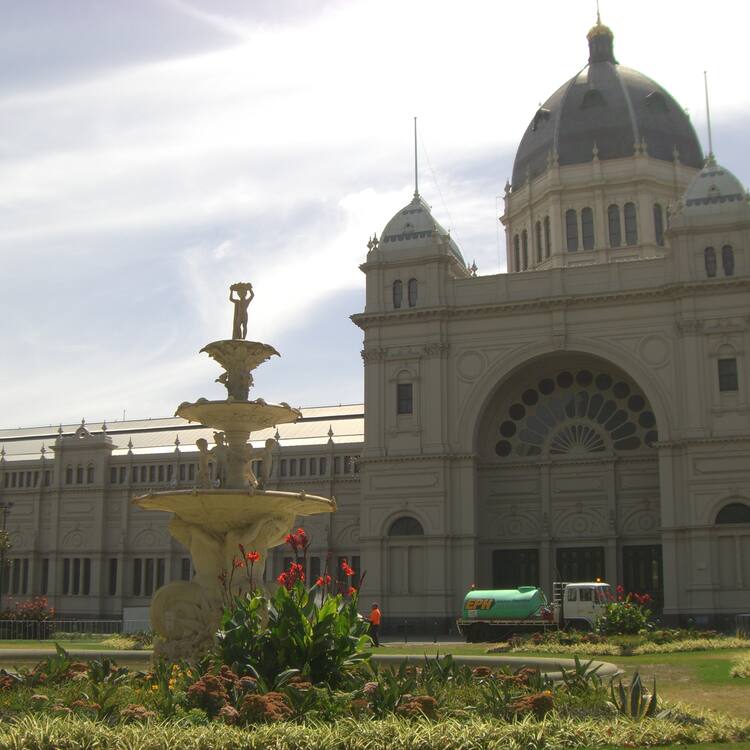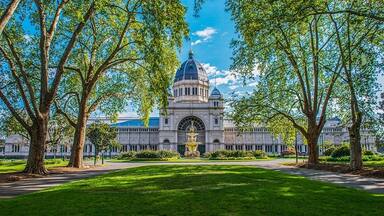Royal Exhibition Building and Carlton Gardens
Royal Exhibition Building and Carlton Gardens
The Royal Exhibition Building and its surrounding Carlton Gardens were designed for the great international exhibitions of 1880 and 1888 in Melbourne. The building and grounds were designed by Joseph Reed. The building is constructed of brick and timber, steel and slate. It combines elements from the Byzantine, Romanesque, Lombardic and Italian Renaissance styles. The property is typical of the international exhibition movement which saw over 50 exhibitions staged between 1851 and 1915 in venues including Paris, New York, Vienna, Calcutta, Kingston (Jamaica) and Santiago (Chile). All shared a common theme and aims: to chart material and moral progress through displays of industry from all nations.
Description is available under license CC-BY-SA IGO 3.0
Palais royal des expositions et jardins Carlton
Le Palais royal des expositions et les jardins Carlton qui l’entourent ont été conçus pour les grandes expositions internationales de 1880 et 1888 à Melbourne. Le bâtiment et le terrain ont été dessinés par Joseph Reed. Le bâtiment, construit en brique, bois, acier et ardoise, amalgame des traits byzantins, romans, lombards et de la Renaissance italienne. Cet ensemble est représentatif du mouvement des expositions internationales. Entre 1851 et 1915, plus de 50 d’entre elles furent organisées dans des villes comme Paris, New York, Vienne, Calcutta, Kingston (Jamaïque) et Santiago du Chili, sur la base d’un principe et d’un objectif commun : dresser un état des lieux du progrès en exposant les réalisations de tous les pays.
Description is available under license CC-BY-SA IGO 3.0
مبنى المعرض الملكي وحدائق كارلتون
تم تصميم مبنى المعرض الملكي وحدائق كارلتون المحيطة لإحتواء المعارض الدولية الكبيرة بين 1880 و 1888 في ملبورن. رسم المبنى والأراضي المحيطة جوزف ريد. وتمّ تشييد المبنى بالقرميد والخشب والمعدن والأردواز (حجر صفائحي ناعم) وخليط من السمات البيزنطية والرومانية واللومباردية ومن النهضة الإيطالية. تمثّل المجموعة حركة المعارض الدولية، فبين 1851 و 1915، تمّ تنظيم أكثر من 50 منها في مدن مثل باريس ونيويورك وفيينا وكالكوتا وكينغستون (جامايكا) وسانتياغو (شيلي) على أساس مبدأ وهدف مشترك: تحديد وضعية التقدّم بعرض إنجازات كل البلدان.
source: UNESCO/CPE
Description is available under license CC-BY-SA IGO 3.0
皇家展览馆和卡尔顿园林
澳大利亚皇家展览馆及其周边的卡尔顿园林,是为1880和1888年墨尔本的盛大国际展览而特别设计的。展览馆由约瑟夫·里德(Joseph Reed)设计。整个展馆和园林由砖、木头、钢和石板等材料建成,风格则融合了拜占庭式、罗马式、伦巴第式以及意大利文艺复兴风格。展览馆专门用于举办国际展览活动,从1851年至1915年,有50余场来自巴黎、纽约、维也纳、加尔各答、牙买加金斯敦、智利圣地亚哥等地的展览在此处举办。所有活动有一个共同的主题和目的:通过对各国工业的展示,记录物质和精神进步。
source: UNESCO/CPE
Description is available under license CC-BY-SA IGO 3.0
Здание Королевской выставки и сады Карлтон (Мельбурн)
Здание Королевской выставки и окружающие его сады Карлтон были спроектированы Джозефом Ридом для проведения больших международных выставок 1880 и 1888 гг. в Мельбурне. Здание выставки было сооружено из кирпича, деревянных и стальных конструкций, покрыто шифером, и объединило архитектурные элементы разных стилей – византийского, романского, ломбардского и итальянского Возрождения. Объект типичен для международных выставок, более 50 из которых были проведены во всем мире между 1851 и 1915 гг.
source: UNESCO/CPE
Description is available under license CC-BY-SA IGO 3.0
Palacio Real de Exposiciones y Jardines Carlton
Proyectados para albergar las dos grandes exposiciones internacionales celebradas en Melbourne en 1880 y 1888, el Palacio Real de Exposiciones y los Jardines Carlton que lo rodean fueron diseñados por el arquitecto Joseph Reed. El palacio, construido con ladrillo, madera, hierro y pizarra, integra diversos estilos arquitectónicos: románico-bizantino, lombardo y renacentista italiano. El edificio es representativo del movimiento de promoción de las exposiciones internacionales, que alcanzó su apogeo entre 1851 y 1915, con la celebración de más de 50 en ciudades de todo el mundo, como París, Nueva York, Viena, Calcuta, Kingston (Jamaica) y Santiago de Chile. Todas esas exposiciones tuvieron el mismo denominador común y un idéntico objetivo: mostrar el progreso material y moral de la humanidad, presentando los productos industriales de todas las naciones del planeta.
source: UNESCO/CPE
Description is available under license CC-BY-SA IGO 3.0
王立展示館とカールトン庭園
王位展示館とそれを取り囲むカールトン庭園は、1880年と1888年にメルボルンで開催された万国博覧会用に建設された。展示館と庭園はジョセフ・リードの設計。建物には、レンガや木材、鋼鉄や粘板岩などが使用されており、ビザンチンやロマネスク、ロンバルディアやイタリア・ルネサンス様式などの要素を組み合わせている。この遺産は、パリやニューヨーク、ウィーン、コルカタ、キングストン(ジャマイカ)およびサンチアゴ(チリ)などで、1851年から1915年までの間に50回以上開催された万国博覧会の建築として典型的なものである。source: NFUAJ
Koninklijke tentoonstellingsgebouw en tuinen van Carlton
Het Koninklijke tentoonstellingsgebouw en de tuinen van Carlton zijn door Joseph Reed ontworpen voor de grote internationale tentoonstellingen van 1880 en 1888 in Melbourne. Het gebouw is opgebouwd uit baksteen, hout, staal en leisteen en combineert elementen uit de Byzantijnse, Romaanse, Lombardische en Italiaanse renaissancestijl. Het pand is typerend voor de wereldtentoonstellingsbeweging die meer dan 50 tentoonstellingen organiseerde tussen 1851 en 1915 in Parijs, New York, Wenen, Calcutta, Kingston (Jamaica) en Santiago (Chili). Alle tentoonstellingen hadden een gemeenschappelijk thema en doel: de materiële en morele vooruitgang in kaart brengen door de industrie van alle naties te etaleren.
Source: unesco.nl
Outstanding Universal Value
Brief synthesis
The Royal Exhibition Building and Carlton Gardens are a surviving manifestation of the international exhibition movement which blossomed in the late 19th and early 20th centuries. The exhibition building was constructed as a Great Hall, a permanent building initially intended to house the Melbourne International Exhibition of 1880 and the subsequent 1888 Melbourne Centennial International Exhibition. These were the largest events staged in colonial Australia and helped to introduce the world to Australian industry and technology.
The site comprises three parcels of Crown Land in the City of Melbourne, being two Crown Land Reserves for Public Recreation (Carlton Gardens) and one dedicated to the exhibition building and the recently-constructed museum (Exhibition Reserve). The inscribed property consists of a rectangular block of 26 hectares bounded by four city streets with an additional 55.26 hectares in the surrounding buffer zone.
Positioned in the Exhibition Reserve, with the Carlton Gardens to the north and the south, is the Great Hall. This building is cruciform in plan and incorporates the typical architectural template of earlier exhibition buildings: namely a dome, great portal entries, viewing platforms, towers, and fanlight windows. The formal Carlton Gardens, with its tree-lined pathways, fountains and lakes, is an integral part of the overall site design and also characteristic of exhibition buildings of this period.
Criterion (ii): The Royal Exhibition Building and the surrounding Carlton Gardens, as the main extant survivors of a Palace of Industry and its setting, together reflect the global influence of the international exhibition movement of the 19th and early 20th centuries. The movement showcased technological innovation and change, which helped promote a rapid increase in industrialisation and international trade through the exchange of knowledge and ideas.
Integrity
The completeness of the inscribed property has been retained with the same boundaries as set out in 1879. The Melbourne Museum was constructed in 1998-2000 to the north of the Royal Exhibition Building.
The present state of the conservation of the Great Hall is very good. Conservation work has recently been undertaken on the building’s dome and structure, the external joinery and stonework, and timber floors. Additionally, upgrades to building services have been completed. The scroll and parterre gardens on the southern side of the exhibition building, which were part of the 1880 Melbourne International Exhibition, have been restored. As part of the restoration of the 1880 German Garden, an extensive water harvesting and storage system has been installed that involved the installation of underground water tanks in the western forecourt to capture roof and surface runoff. The formal ornamental palace garden, being the southern part of the Carlton Gardens, provided the context for the Palace of Industry and is substantially intact in form including its treed avenues. These works contribute to maintaining the integrity of the Royal Exhibition Building and Carlton Gardens.
Authenticity
The property of the Royal Exhibition Building and Carlton Gardens has retained high authenticity of setting, maintaining its original form on the international exhibition site defined in 1879. The site is still surrounded by city streets and is edged by the bluestone plinth, the base of the iron railings that bounded the 1880 exhibition grounds.
The 1880 Great Hall survives substantially intact in its form and design, internally and externally. Authenticity of form is manifest in its survival as the only Great Hall from a major industrial exhibition of the late 19th and early 20th century. The east and west annexes, not part of the original design and intended to be of temporary use only, were demolished in the mid 20th century. Some modern interventions have been reversed including two structures attached to the north elevation in the 1960s and 1970s which were removed and the original structure repaired. Recent restoration works have included the reinstatement of missing ornamentation around the parapet line.
Interior spaces have been largely retained and are once again used for large-scale exhibitions demonstrating a relatively high authenticity of function within the Great Hall. Prompted by fire safety concerns, most of the original timber staircases were replaced by concrete early in the 20th century, an acceptable risk-sensitive reduction in material authenticity. In 1994, major restoration work included the reworking of the interior colour scheme to the documented era of 1901. The ornate internal paintings have mostly been replaced by the third decorative scheme of 1901, however, parts of the 1880 murals are still intact.
The museum’s construction removed part of the north garden although the surviving garden has retained its late 19th century layout. The original axial layout of the south garden survives with its formal paths, tree clumps and central avenues, lawn areas and two lakes (although reduced in size) and fountains. One fountain, the 1888 Westgarth Fountain, has been relocated. A high number of the trees extant on the site are from the 1880s and 1890s layout. Restoration of garden pathways and plantings are based on research.
Protection and management requirements
The property has effective legal protection and a sound planning framework. The management system takes into account a wide range of measures provided under planning and heritage legislation and policies of both the Australian Government and the Victorian Government. The Burra Charter principles support the Conservation Management Plan for the Royal Exhibition Building and Carlton Gardens and the World Heritage Environs Area Strategy Plan. Together these documents provide the policy framework for conservation and management. The property is maintained and preserved through regular and rigorous repair and conservation programs undertaken at all levels of government.
The Royal Exhibition Building is managed as an integral part of Museum Victoria, the state museum. The Carlton Gardens are managed by the City of Melbourne.
The Royal Exhibition Building and Carlton Gardens was included in the National Heritage List in 2004 under the Commonwealth Environment Protection and Biodiversity Conservation Act 1999 (EPBC Act) and on the State Heritage Register of Victoria in 1998 under the Heritage Act 1995. Inclusion in the National Heritage List requires that any proposed action to be taken inside or outside the boundaries of a National Heritage place or a World Heritage property that may have a significant impact on the heritage values is prohibited without the approval of the Federal Minister. Inclusion in the Victorian Heritage Register means that works inside the boundaries of the registered place are prohibited without approval under the Heritage Act 1995.
A Conservation Management Plan for the whole site was finalised in 2009. A buffer zone, the World Heritage Environs Area, covering an additional 55.26 hectares, was established in 2010 and has been supplemented by the World Heritage Environs Area Strategy Plan. Changes to local government heritage overlays have been made to give effect to this plan. Any future developments immediately outside the World Heritage Environs Area, which are likely to have a significant impact on the World Heritage values of the Royal Exhibition Building and Carlton Gardens, are subject to the provisions of the EPBC Act.

 View photos from OUR PLACE the World Heritage collection
View photos from OUR PLACE the World Heritage collection
